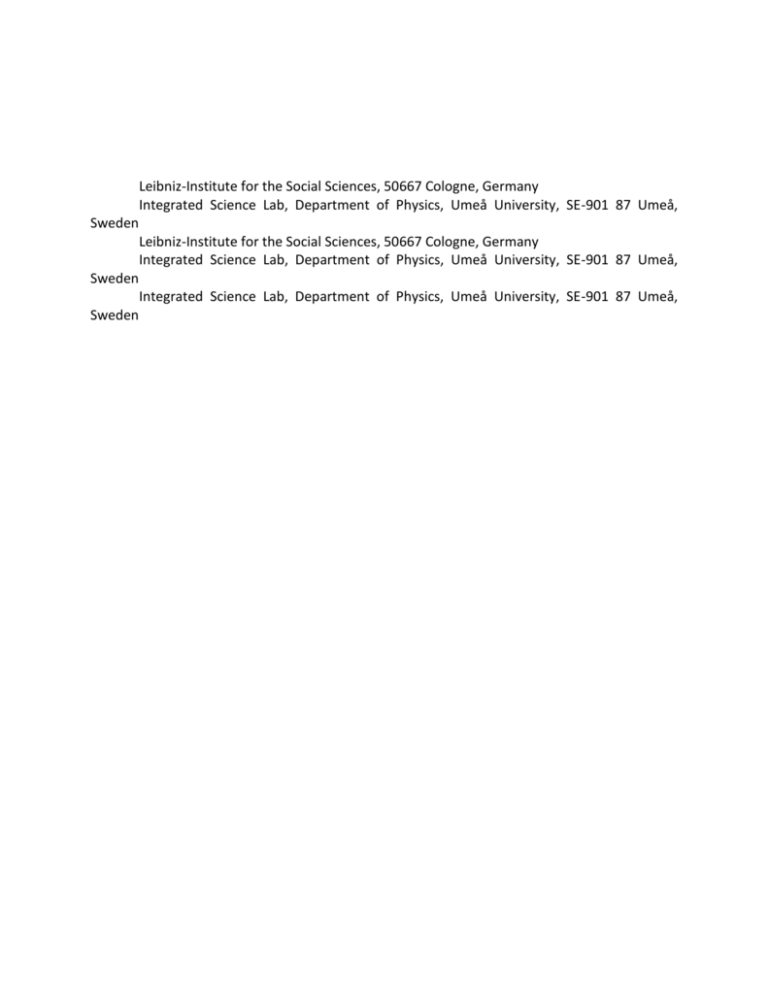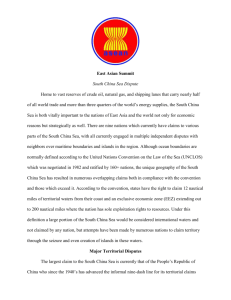Supplementary Information
advertisement

Leibniz-Institute for the Social Sciences, 50667 Cologne, Germany Integrated Science Lab, Department of Physics, Umeå University, SE-901 87 Umeå, Sweden Leibniz-Institute for the Social Sciences, 50667 Cologne, Germany Integrated Science Lab, Department of Physics, Umeå University, SE-901 87 Umeå, Sweden Integrated Science Lab, Department of Physics, Umeå University, SE-901 87 Umeå, Sweden Supplementary Information - Mapping bilateral information interests using the activity of Wikipedia editors Fariba Karimi, Ludvig Bohlin, Ann Samoilenko, Martin Rosvall, Andrea Lancichinetti S1 Derivation of multinomial mean and variance To find connections in interest, we measure the co-occurring edits of two countries in the same articles. We quantify the connection with an empirical weight that is computed as the product of the countries' edit activities in the article. For a Wikipedia article a , if the total edit activity of country i is denoted by k ia , and for country j is k aj , then we calculate the empirical weight, wija , according to (1) wija = kia k aj . As the total edit activity of countries differs, the probability that countries appear together in a certain article varies. If the total number of edits for all articles is M , then the expected proportion of edits for country i is a kia (2) pi = . M This is the probability of country i making a random edit overall, and this is the null model we use to filter noisy connections in the interest model. Assume that there is a total of c countries, and a total of n edits for article p . Let xk denote the number of edits from country k . Then the probability of any particular combination of edits for the various countries follows a multinomial distribution c n! x x (3) p1 1 ... pc c , wherexi = n. x1!...xc! i =1 With the above distribution, we can compute the expected probability of the co-occurrence of two countries i and j in an article n! x x (4) ija = xi x j p1 1 ... pn n x1!...xn! 1...k Following the multinomial theorem, we can now calculate the mean, variance and covariance matrices for the occurrence of a country pair. The mean value of the co-occurrence of two countries becomes (5) ija = na (na 1) pi p j . Using the multinomial theorem multiple times, one can also compute the variance: (6) ( ija )2 = na (na 1) pi p j ((6 4na ) pi p j (na 2)( pi p j ) 1). Thus, the standard deviation of the pair, ija , is the square root of equation (6). This equation enters into the definition of the z -score. The sum of the z -scores is then approximated with a Gaussian distribution. This approximation is well justified by the large number of articles. In practice, already 1, 000 articles give a good approximation, as shown by the numerical simulations in Figure 1. Supplementary Figure 1: Cumulative distribution function of analytic and simulation results for topic co-occurrence for Great Britain and Germany (1000 documents were considered). The empirical cumulative distribution is approximated with the cumulative of a Gaussian distribution with average equal to zero and standard deviation equal to 1000 , as expected by the central limit theorem when summing 1000 variables with zero average and unit variance. Supplementary Figure 2: Clustering results. In total 234 countries assigned to 18 clusters Cluster 1 2 Countries Saudi Arabia, United Arab Emirates, Egypt, India, Kuwait, Jordan, Qatar, Pakistan, Bahrain, Palestine, Oman, Algeria Morocco, Lebanon, Syria, Iraq, Tunisia, Yemen, Bangladesh, Libya, Sri Lanka, Iran, Nepal, Maldives, Israel, Mauritius Afghanistan, Bhutan, Eritrea Argentina, Colombia, Venezuela, 3 4 Guatemala, Peru, Mexico, Chile, Ecuador, Uruguay, Honduras, Costa Rica, Dominican Republic, Panama, Paraguay, El Salvador, Bolivia, Puerto Rico, Nicaragua, Cuba Hong Kong, Taiwan, China, Malaysia, Singapore, South Korea, Vietnam, Indonesia, Thailand, Macau, Japan, Cambodia, Burma (Myanmar), Brunei, Mongolia, Laos, TimorLeste Russian Federation, Ukraine, Belarus, Azerbaijan, Kazakhstan, Latvia, Armenia, Estonia, Georgia, Lithuania, 5 6 7 Moldova, Romania, Turkey, Uzbekistan, Kyrgyzstan, Turkmenistan, Tajikistan Serbia, Bosnia and Herzegovina, Montenegro, Croatia, Macedonia, Greece, Bulgaria, Slovenia, Cyprus, Albania South Africa, Sudan, Zimbabwe, Cameroon, Democratic Republic of the Congo, Botswana, Zambia, Namibia, Mozambique, Swaziland, Equatorial Guinea, Guinea, Madagascar, Malawi, Lesotho, Sao Tome and Principe France, Switzerland, Austria, Germany, Belgium, Netherlands, 8 Luxembourg, Monaco, Suriname, Liechtenstein, French Polynesia, New Caledonia, Mayotte, Réunion, Saint Pierre and Miquelon United States, Canada, Bermuda, Palau, Bahamas, Caribbean Islands Caribbean Islands in the list are: Jamaica, Trinidad and Tobago, Saint Lucia, Barbados, Antigua and Barbuda, Guyana, Saint Kitts and Nevis, Grenada, Saint Vincent and the Grenadines, Belize, US Virgin Islands, Dominica, Cayman Islands, British Virgin Islands, 9 10 11 12 Anguilla, Turks and Caicos Islands. Nigeria, Senegal, Ghana, Ivory Coast, Burkina Faso, Benin, Mauritania, Mali, Liberia, Niger, Gambia, Gabon, Togo, Republic of the Congo, Chad, Central African Republic Kenya, Uganda, Djibouti, Somalia, Tanzania, Rwanda, Ethiopia, South Sudan, Burundi, Comoros Sweden, Denmark, Norway, Finland, Greenland, Faroe Islands, Iceland, Åland Islands, Malta Curaçao, Saint Martin, Guadeloupe, Sant Maarten, French Guiana, Aruba, 13 14 15 16 Martinique, Haiti, Wallis and Futuna Slovakia, Czech Republic, Hungary, Poland, Niue Fiji, New Zealand, Australia, Samoa, Vanuatu, Kiribati, Cook Islands, Tonga, Solomon Islands, Papua New Guinea, Nauru, Marshall Islands, American Samoa, Norfolk Island Spain, Portugal, Angola, Brazil, Cape Verde, Andorra, Guinea-Bissau United Kingdom, Ireland, Guernsey, Jersey, Isle of Man, Sierra Leone, Gibraltar, Falkland Islands, Tuvalu, British Indian Ocean Territory 17 18 Philippines, Guam, Northern Mariana Islands, Micronesia Italy, San Marino, Holy See (Vatican City) Supplementary Figure 3: Top 10 Wikipedia articles that Germany-Austria and SwedenNorway co-edit based on the filtering analysis Rank 1 2 3 4 5 6 7 8 9 10 DE-AT SE-NO Christina Tipuloidea Stürmer Erste Dansband Allgemeine Verunsicherung Steffen Boyoz Hofmann Nazar (rapper) Fredrik Skavlan Piefke Erik Hamrén ATV (Austria) Sweden Klagenfurt Anders Karl-Heinz Peter Grasser Jöback Wolf Haas Causerie Zillertal List of the busiest airports in the Nordic countries S2 Data for the regression analysis Geographical proximity The geographical proximity is calculated as the euclidean distance between each pair of countries using Haversine formula. The point for each country is based on the rounded latitude and longitude of the centroid or the center point of the country [1]. Trade data Data on free trade areas and customs union (FTAs) are collected for the year 2000 [2]. WTO members are obliged to notify the regional trade agreements in which they participate. 157 countries reported their trade flow in 2000. The trade volume is estimated by averaging the import and export volume of each pairs of countries. [3]. Colonial ties We used Colonial history dataset available to download at [4]. We create a tie between two countries if they had a colonial relationship since 1900 until now. Language similarities The data from languages that are spoken in each countries are collected from Ethnologue [5]. The data contains information on more than 7000 known living languages in the world. It is regarded to be the most comprehensive source of information about languages. From the data, we weight each pair of countries dependent on number of languages that are co-spoken. Shared religion The data on the religion composition of countries was taken from World Religion database shared_relig. The results is a binary matrix where countries that share the same religion have non-zero entities. References [1] titleCIA fact book, howpublished = https://www.cia.gov/library/publications/theworld-factbook/fields/2011.html, note = Accessed: 2015-06-01. [2] titleWTO - Trade and tariff data, howpublished = https://www.wto.org/english/res_e/statis_e/statis_e.htm, note = Accessed: 2015-06-01. [3] authorSubramanian, A. & authorWei, S.-J. titleThe wto promotes trade, strongly but unevenly. journalJournal of international Economics volume72, pages151--175 (year2007). [4] titleICOW Colonial History Data Set, version 1.0., howpublished = http://www.paulhensel.org/icowcol.html, note = Accessed: 2015-06-01. [5] titleEthnologue, howpublished = http://www.ethnologue.com/, note = Accessed: 2015-06-01. [6] titleWorld Religion Database, howpublished = http://www.worldreligiondatabase.org//, note = Accessed: 2015-06-01.







